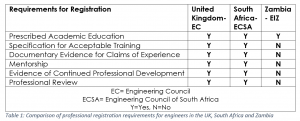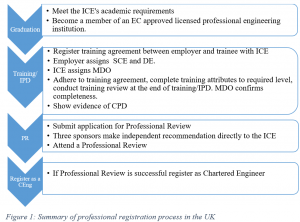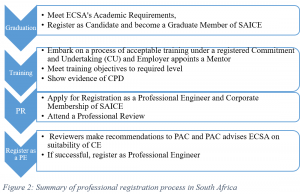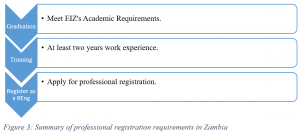By Habeene Habeenzu Pr. Eng (ECSA)
Introduction
In brief, a professional engineer is an engineer who has been designated as having adequate education and professional experience to a level where he or she is accountable and takes responsibility for engineering work. This designation is conferred upon by a body or institution that is mandated to regulate the engineering profession in a country. As the title of professional engineer has serious consequences, it is important that measures are put in place to ensure that individuals conferred upon as professional engineers are adequately assessed for competence. In this article, a review of the registration requirements for engineers in the United Kingdom (UK), South Africa (SA) and Zambia is assessed. Though biased to civil engineering, the principals discussed are similar with registration requirements in other engineering fields.
The table below summarises the requirements for registration in the three countries reviewed.

Registration of Engineers in the United Kingdom (UK)
Engineering in the UK is regulated by the Engineering Council which operates under the authority of a Royal Charter. The Engineering Council sets the standard for competence and commitment and maintains the register of engineering professionals who have achieved the necessary level of competence and commitment in their respective category of registration. Registration is open to all engineers and technicians who can demonstrate competence and commitment to perform professional work to the necessary standard. (Council, 2014) The required standard is set out in the UK Standard for Professional Engineering Competence (UK-SPEC), currently in its third edition, which for all engineering professionals covers the following five generic areas of competence and commitment:
- Knowledge and understanding
- Design and development of processes, systems, services and products
- Responsibility, management or leadership
- Communication and inter-personal skills
- Professional commitment
The UKSPEC defines competence as the ability to carry out a task to an effective standard and requires the right level of knowledge, understanding and skill, and a professional attitude. Achieving competence is only the beginning to a lifelong commitment to continuous development and is appropriately recognized so and termed Initial Professional Development (IPD).
Commitment deals with acceptable behaviour, ethics and values with respect to the engineer’s accountability to society. In this regard, the council requires that an engineer demonstrates his commitment to areas such as:
- Complying with codes of conduct
- Managing and applying safe systems of work
- Undertaking engineering activities in a way that contributes to sustainable development
- Carrying out CPD necessary to maintain and enhance competence
- Actively participating in the profession.
The Engineering Council (EC) is empowered under the Royal Charter to license various institutions, known as licensed professional engineering institutions, such as the Institution of Civil Engineers (ICE) to assess candidates for PR. So the first step to registration is membership to one of these licensed professional engineering institutions. The EC requires that any claim of qualifications, experience or training must be accompanied by documentary evidence. To meet this, the ICE has developed a training scheme ((ICE), 2017) which can be used to provide the necessary documentary evidence. The key players in the ICE training scheme are:
- The employer;
- The trainee; and
- The ICE.
Normally, IPD is achieved while a trainee is in formal employment. Employers as part of their commitment to the profession are required to provide Supervising Civil Engineers (SCEs) to mentor trainees through their IPD. Employers may also assign a Delegated Engineer (DE) to assist the SCE. SCEs are assessed and approved for suitability by the ICE.
For every trainee, the employer also enters into a training agreement which is registered with the ICE. The training agreement is basically a commitment by both the employer and the trainee that they will commit themselves to ensure that the trainee gets the best possible opportunities to complete the IPD. Should the trainee fail to live up to this agreement, the employer may terminate the agreement.
The ICE provides an online platform for the trainee to keep a record of their experience, achievements and CPD activities. The ICE further provides a dedicated Membership Development Officer (MDO) who “is responsible for ensuring that the training is as effective as possible, in the short and long term.”
Trainees have a lot of support to successfully complete their IPD from the employer through the SCE and also from the ICE. None the less, the trainee is expected to be proactive and take the initiative in gaining the right experience.
The trainee records their learning and experience against the set attributes i.e. training objectives, online. The SCE has access to this online record and validates it. The trainee further prepares quarterly reports for their training which form the basis for the quarterly meetings with their SCE. These reports cover the activities and what has been done during the period, the attributes that have been achieved and to what level the attributes have been achieved (The SCE may require the trainee to produce additional reports).
The level of achievement for a particular attribute is generally in three levels:
- Knowledge- having a basic understanding and knowledge in the area of competence;
- Experience- having achieved the attribute while under the direct supervision of a registered professional;
- Ability- successfully achieving the attribute without supervision.
The level required per attribute is dependent on the category of registration which is being aimed for. When the required level of competence is achieved for a particular attribute, the SCE signs off that attribute as achieved.
Annually the SCE is required to carry out an annual appraisal of the trainee’s progress. The SCE uses the online IPD record to assess the trainee’s progress towards achieving the required level of competence for each attribute. The annual appraisal is also used to set the goals for the next 12 months.
When all the attributes have been signed off as achieved, the SCE performs the training review which is the last stage of the training agreement. The purpose of this training review is to ensure that the trainee has:
- Achieved the attributes required for the grade of membership they’re applying for
- Completed the development reports (where required by the SCE)
- Maintained the development action plan and personal development record and achieved the minimum number of hours of CPD needed for the grade of membership they are applying for.
When the training review and associated documents are finalised the trainee notifies the MDO who is then required to verify the completion. The trainee is then ready for the Professional Review for registration. A Professional Review (PR) is a peer-review process which provides the candidate the opportunity to demonstrate that they have achieved the required competence.
The Professional Review process comprises the following steps:
- Initial Application
- Professional Review submission
- The Professional Review itself
The initial application includes submission of an application form, payment of the required fees and submission of what are termed sponsor questionnaires. Three sponsors are required to submit their recommendations directly to the ICE through a prescribed questionnaire. A sponsor is any engineering professional who is in an equal or high category than the trainee is applying for. The sponsor is essentially required to vouch for the trainee that “the candidate is a fit and proper person for admission to membership.”
When the initial application is deemed acceptable the trainee is then asked to submit a detailed submission for consideration and which includes:
- The Professional Review report which demonstrates how the trainee has achieved the relevant attributes and includes a two-page CV;
- Appendices
- CPD records
The detailed submission is reviewed and if deemed adequate the trainee will be invited to attend the professional review where the trainee will be required to make a 15-minute presentation to reviewers based on a topic, or topics, covered in the trainees Professional Review Report. The trainee will also be interviewed by the reviewers to “confirm that the trainee has achieved the required level of competence” as stated in his report. The candidate will then be presented with two questions of which he will have to answer one.
Candidates are notified via email of the outcome of their PR review and simultaneously published on ICE’s website. The process for registration in the UK is summarised in figure 1 below.

Registration of Engineers in South Africa (SA)
Engineering in South Africa is regulated by a statutory body established by the Engineering Profession Act (EPA), 46 of 2000 called the Engineering Council of South Africa (ECSA). Its core functions include accreditation of engineering programmes, registration of persons as professionals in specified categories, and the regulation of the practice of registered persons.
The process of registration of engineers in South Africa is largely similar to that required by the Engineering Council of the United Kingdom. ECSA has developed discipline-specific guidelines for professional registration for each discipline of Engineering.
In South Africa, graduates of engineering must apply to be registered as Candidate Engineers (CEs) with ECSA. Policy statement R2/1A Acceptable Engineering Work for Candidate Engineers for Registration as Professional Engineers describes the experience and practical training (competence) which a candidate is required to undergo to be registered as a professional engineer. (Engineering Council of South Africa, 2004)
The policy describes professional engineers as those who “are concerned primarily with the progress of technology through innovation, creativity and change. Their work involves the application of a significant range of fundamental principles, enabling them to develop and apply new technologies, promote advanced designs and design methods, introduce new and more efficient production techniques, marketing and construction concepts, and pioneer new engineering services and management methods. They may be involved with the management and direction of high risk and resource-intensive projects. Professional Engineers undertake and lead varied work that is essentially intellectual in nature, requiring discretion and judgment. Such work has its base in proficiencies and competencies derived from and extended by experience and research. It is concerned with cost-effective, timely, reliable, safe, aesthetically pleasing and environmentally sustainable outcomes.”
The policy encourages CEs to undertake structured practical training. This is achieved by ensuring that employers register a Commitment and Undertaking (CU) with ECSA and provide CEs with individual mentors to guide them through the process. Mentors are only required to be registered professional engineers to qualify as mentors. Experienced and mature professional technologists may be considered as mentors.
The CEs training and development is recorded via a training schedule. The training schedule outlines in details the training objectives (attributes) which are designed to meet ECSA’s requirements for acceptable training. For Civil Engineers, the objectives in brief include:
- Professional Attributes (understanding the professional environment)
- Understanding the statutory and the relationships between various engineering associations;
- Code of professional conduct;
- ECSA policy documents;
2.Technical Competence
- Developing an engineering brief;
- Designing a solution;
- Documentation;
- Implementation;
There are four levels of competence and each training objective is assigned a required level. The levels of competence are:
- Appreciation- CEs must demonstrate that they have a general appreciation of the subject matter as well as of the reasons for its inclusion in the training programme.
- Knowledge- CEs must demonstrate that they have sufficient knowledge of how to carry out the processes that are necessary to meet the objectives. This knowledge would be in addition to “appreciation” mentioned in 1 above.
- Experience- CEs must demonstrate that they have, independently or under supervision, performed the processes relating to each objective. Experience of the relevant techniques and functions must be gained in addition to “appreciation” and “knowledge” mentioned in 1 and 2 above.
- Capability- CEs must demonstrate that they have the capability, independently or (at most) with limited guidance, of performing the process and making the decisions required to reach the objectives of each element and also that they have the capability of leading or supervising others in the process. This capability must be in addition to “appreciation”, “knowledge” and “experience” stated in 1, 2 and 3 above.
CEs’ progress are assessed through quarterly interviews with their mentors. All interviews are recorded on an interview form which forms part of application for the PR. Once the required level for a particular objective is achieved mentors are required to confirm by signing off that training objective.
CEs are required to submit regular training reports to their mentors which must follow the prescribed format and will also form part of the application for PR. Once all the training objectives have been achieved the CE is ready to apply for PR. The application for PR includes:
- The application form;
- Payment of the prescribed fees;
- Membership of voluntary associations;
- Completed training/experience reports and interview record;
- Two referee reports(submitted directly to ECSA);
- Engineering Report;
- Proof of CPD.
When submitted, the application is first assessed for adequacy and if deemed acceptable, the CE will be called for the PR.
The PR is conducted by two reviewers and consists of a 15-minute presentation of the CEs experience, an interview to assess the claimed competence of the CE and two written essays. The reviewers will make their recommendations to a Professional Advisory Committee, composed of experienced engineers, who review the entire process the CE has undergone and they make a recommendation to ECSA as to whether the CE has met the required standards for registration.
The discipline-specific guidelines for civil engineers details the process of training and is as summarised in figure 2 below:

Registration of Engineers in Zambia
Engineering in Zambia is regulated by the Engineering Institute of Zambia (EIZ) established by The Engineering Institution of Zambia Act, 2010. The Act provides for the establishment of a registration board which is mandated to perform all the registration functions on behalf of the EIZ. The board is mandated under the act to prescribe the “knowledge, training and experience” required for registration. This requirement, however, has not been published but is generally understood as four years of work experience.
Under the heading, “Who should Register?” on the EIZ website, it states:
“Any person who is academically qualified as an engineer and wishes to practice his profession in Zambia must apply to the Engineers’ Registration Board for registration.
Candidates applying for registration should submit the following:
- Completed and signed application form prescribed by the Board.
- Copy of EIZ membership certificate.
- Two passport-size photographs.”
The EIZ website (The Engineering Institute of Zambia, 2017) further guides that one may be registered as a Professional Engineer if that person:-
(a) has attended an approved university, college or school and holds a degree or other qualifications acceptable to the Engineering Council for this class of membership; and
(b) at, or not more than one year before the time of making the application for admission as a Professional Engineer, is or has been:-
(i) engaged in the administration, design, execution of professional work or research of approved nature for a period of at least two years; or
(ii) employed as a lecturer or teacher for a period of at least four years inclusive of postgraduate training;
A person may, on application to the Council of Engineers be admitted as a Member if that
(c) (i) either has undergone training in industry or at postgraduate level acceptable to the Engineering Council for a period of at least two years under an approved professional person; or satisfies the Engineering Council that he/she has other suitable professional training; and
(ii) has after such training, gained relevant experience of at least two years, one of which should be in a responsible position as determined by Council.
Note that the “approved nature” or “relevant experience” is not defined anywhere.
The summary for registration in Zambia may be summarized as:

Conclusions and Recommendations
Comparing figures 1-3 above, it is apparent that the process for registration of engineers in Zambia is inadequate and falls far below international standards. The process does not define the required competence nor the level of competence to be achieved. There is also no mechanism to monitor or confirm that indeed an applicant has the “relevant experience.” Further, candidates pursuing professional registration in Zambia have no support in the form of mandatory mentorship nor is there a detailed professional review process.
These gaps have negative consequences for the engineering profession in Zambia. For example, the EIZ in its vision aspires “to be a world-class professional institution that promotes best engineering practice and technological innovations.” Can this vision be achieved without a world-class membership?
A lot of the problems in the engineering profession in Zambia such as the high cost of public infrastructure can be directly related to poor engineering competence. It is thus imperative that registration requirements for engineers are brought in line with international standards. Without improvements to our requirements for professional registration, the profile of engineering in Zambia will continue to suffer low public confidence levels until the members themselves are held to a high standard of membership. Note that the engineering profession is behind other professions in Zambia such as health professionals and lawyers when it comes to requirements for professional registration.
Further, our professional fees will continue being undervalued and yet the same services by foreign engineers will gladly be paid at a premium and complex engineering tasks will continue being the privy of foreign engineers and as a result engineering as a career in Zambia will continue to suffer from low professional satisfaction.
The cost of poor quality engineering professionals is simply too great to ignore. Deliberate steps should be taken by the EIZ in the short and long term and may include:
- The EIZ must immediately put international recognition as one of its strategic objectives and begin working towards achieving the minimum international requirements for competence and commitment. This is no easy task, but institutional mentorship to this end is readily available internationally.
- The Engineers registration board should define the vague terms “relevant experience” and “approved nature” by clearly defining what constitutes work of an approved nature or relevant experience. Further, a mechanism must be put in place to monitor and confirm that the required training experience has been achieved. Formal interviews (professional reviews) can also be conducted to assess applicants.
- The EIZ must begin a mandatory mentorship of would be registered professional engineers. A pool of mentors can be obtained from the current Fellows of the institution. The EIZ can go further by mandating that anyone registered as a Fellow must mentor a minimum number of young engineering professionals.
- The EIZ must mandate CPD as a prerequisite for registration. Note that even continued professional membership in the UK and South Africa is dependent on members achieving the minimum levels of CPD in a particular period.
In conclusion, we should ever keep in view the public trust vouched to us. Engineers have a crucial role to play in the socio-economic progression of our society and we must do everything we can to ensure that the public benefits from adequately educated and trained engineers. The title engineer is and should be sacred. The honour we ascribe to the title will show by the price we set to obtain it.
References
[1] E. Council, UK Standard for Professional Engineering Competence (UK-SPEC), 2014.
[2] T. I. o. C. E. (ICE), ICE Training Scheme and Guidance, 2017.
[3] E. Engineering Council of South Africa, Policy Statement R2/1A- Acceptable Engineering Work for Candidate Engineers for Registration as Professional Engineers, 2004.
[4] E. The Engineering Institute of Zambia, “Engineering Institute of Zambia Website,” November 2017. [Online]. Accessed 01/09/2017. Available: http://www.eiz.org.zm/membership/membership-classes/.
